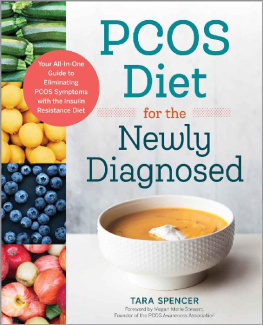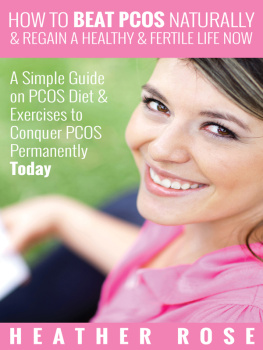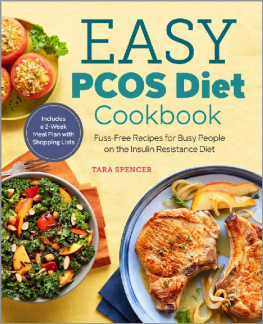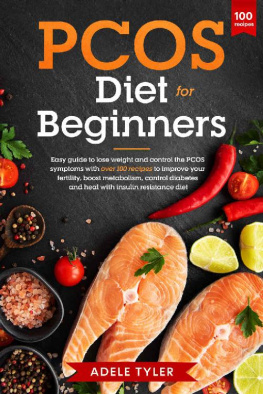PCOS Nutrition
A Complete PCOS Diet Plan Book with 4 Week Meal Plan, Recipes for a Healthy Lifestyle, and 4 Week Fitness and Exercise Plan to Reduce Your Weight and Prevent Diabetes. PCOS Causes and Symptoms.
Mia Collins Parker
Copyright 2020 - All rights reserved.
The content contained within this book may not be reproduced, duplicated, or transmitted without direct written permission from the author or the publisher.
Under no circumstances will any blame or legal responsibility be held against the publisher, or author, for any damages, reparation, or monetary loss due to the information contained within this book, either directly or indirectly.
Legal Notice:
This book is copyright protected. It is only for personal use. You cannot amend, distribute, sell, use, quote or paraphrase any part, or the content within this book, without the consent of the author or publisher.
Disclaimer Notice:
Please note the information contained within this document is for educational and entertainment purposes only. All effort has been executed to present accurate, up to date, reliable, complete information. No warranties of any kind are declared or implied. Readers acknowledge that the author is not engaged in the rendering of legal, financial, medical, or professional advice. The content within this book has been derived from various sources. Please consult a licensed professional before attempting any techniques outlined in this book.
By reading this document, the reader agrees that under no circumstances is the author responsible for any losses, direct or indirect, that are incurred as a result of the use of the information contained within this document, including, but not limited to, errors, omissions, or inaccuracies.
Table of Contents
Introduction
When I was first diagnosed with polycystic ovary syndrome (PCOS), I was in my mid-twenties. The reason I happened to stumble across having this disorder was a simple and very honest one, which I think happens to many women. I was married and talk had started of starting a family. To know whether or not I was healthy enough and capable of getting pregnant, I decided a trip to the doctor would be wise. You know, to clear the air of any concerns I might have. At the time I was what I thought a healthy, relatively fit, young woman capable of having babies at the drop of a hat. I was proven wrong
I had always resolved myself to being classed as the chubby one in my family. Even though I participated in school and college sports, the weight around my waist in particular never shifted. My cycle was here and there, and so was the quality of my skin. I also assumed that the dark hair on my arms and areas of my face was because I was pale-skinned. These were all symptoms of PCOS that I viewed as separate issues; instead of lumping them together to treat one cause, I tried dieting to shed the weight. I exercised harder, I waxed my arms, went for facials, and bought enough sanitary items to cover barely any flow to heavy flow. And that is how I lived.
At least until the day that the doctor showed me on the ultrasound, and the millions of tiny cysts that covered my ovaries. I was told I would have a difficult time falling pregnant, and if I did not do something about the weight and my diet, the problem would persist. I was also in line for developing type 2 diabetes, which runs in my family, and that scared me. I returned to my husband and family with what I thought would be a life sentence until I began talking to friends about it.
The more I spoke about it, the more people I came across that suffered from it. I searched the internet for websites, social media groups, and forums to find the help I needed. There were PCOS support groups I found via Facebook and online forums such as patient.info with patients like me that all proved helpful.
After taking a hard look at my life, I made contact with a nutritionist and dietitian. I spoke to the gym about a more focused routine. I vowed to start loving myself more and see to the stressors in my life which were causing both mental and physical problems too. I even saw a psychologist to help me get back on track with breaking old self-deprecating habits and put a lid on my depression.
PCOS no longer governs my life as it did back then, and I am glad that I was diagnosed earlier on. Through making healthier choices; keeping not only a journal but a food diary, exercising, and learning to be mindful have kept me from falling back into my old ways and it has taught me to treat myself with respect. Something that I hope my now four-year-old son will learn from me. You see, there is a light at the end of the tunnel for you. All it takes is a little know-how and you are more than halfway there.
This book is here to help you along the way and provide a map to overcoming your diagnosis.
Chapter 1: What You Need to Know About PCOS
Polycystic ovary syndrome (PCOS) is a very common condition that affects a woman's hormonal levels and reproductive system. It is also one of the leading causes of infertility that affects over five million American women who are of reproductive age ( PCOS (Polycystic Ovary Syndrome) and Diabetes , 2020).
Studies show that over 10% of women struggle with this disorder worldwide, of which less than 50% will ever get diagnosed (Medling as cited by Further Food, 2020).
PCOS can present during the course of a woman's life from the time they enter puberty through to their post-menopausal years. The syndrome affects all women, regardless of ethnicity or race. The symptoms of PCOS can include:
Infertility
Acne
Irregular menstrual cycle, or heavy bleeding
Weight gain
Insulin resistance
Hair loss
Excess dark hair
Headaches
Ovarian cysts
Depression
What you must understand is that not every woman will struggle with all the above-mentioned symptoms; each case is unique. Not all women with ovarian cysts have PCOS. This condition is categorized by showing signs of at least two of the symptoms listed above.
What Causes PCOS?
Doctors are still unclear as to what causes the syndrome but it has been suggested that family history, weight, higher levels of inflammation, and insulin resistance may play a part in an increased likelihood of developing the disease.
Polycystic ovary syndrome is when the body creates small sacs filled with fluid that grow inside the ovaries. The word polycystic actually means many cysts. These sacs contain small follicles that contain eggs. The eggs are considered immature, and interfere with ovulation.
This can lower a woman's reproductive hormones and subsequently increase androgen. Higher levels of androgen cause the majority of the symptoms and can cause a woman to get fewer menstrual cycles throughout the year.
Although primarily considered a male hormone, androgen is naturally present in both men and women. Women produce between 5 and 10 percent of this hormone in relation to their male counterparts. Any increase in this hormone will leave a woman remarkably sensitive to suffering from its effects, leaving them vulnerable to developing the symptoms of PCOS as listed (Better Health, 2019).
PCOS cannot be cured, but it can be managed. Failure to do so may lead an individual to suffer further complications that include:
Suffering from a stroke
Sleep apnea
Gestational diabetes
Diabetes (More than half of women with PCOS will develop type 2 diabetes by age 40.)
Heart disease
Higher levels of LDL (bad cholesterol) and lower levels of HDL (good cholesterol)
Increased blood pressure
How is PCOS Diagnosed?







